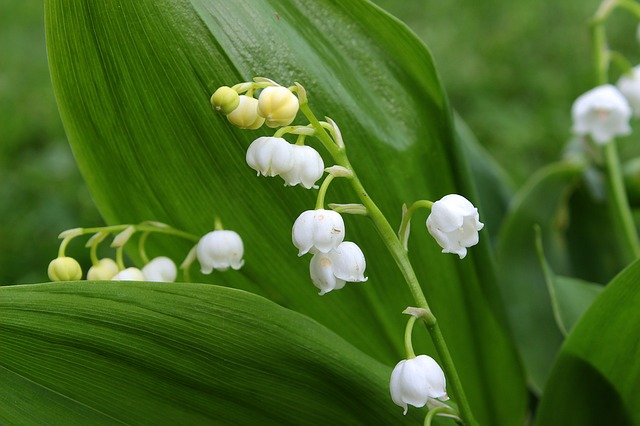 |  |  |  |  |
 |  |
Lily-of-the-valley
is a perennial plant with a height of 15-30 cm. The plant has a complex, long, horizontal, creeping, branched rhizome bearing scaly leaves at the nodal points, with buds at the axils. From them, in turn, new rhizomes develop.
Lily-of-the-valley
is a geophyte, only the rhizome remains in the soil in winter. The aboveground part is bare, the lower part of the stem is wrapped with a light pink film. The plant has only two normally developed leaves, they are large, elongated elliptic or oval-lanceolate, pointed and with a whole edge, length 8-15cm, width 3-6cm.
The flowers are white, aromatic, bell-shaped, small (<8mm), arranged on a one-sided spike, on a long, glabrous, three-sided, pale green stem.
Fruits - orange-reddish berries, 6-8 mm in diameter. Blooms in May, fruits ripen in August-September.
The above-ground part of the plant is harvested for medicinal purposes. Flowers are collected during flowering, leaves approximately 2-3 weeks before flowering, because during this time the amount of cardiac glycosides in them is twice as much as during flowering.
The plant is harvested in dry weather, after the dew has dried. The usual
Lily-of-the-valley
is cut at a height of about 3-5 cm above the ground. Dry in a shaded and well-ventilated place to prevent the plant from browning. It can also be dried in forced dryers at a temperature not exceeding 40-50C. It is necessary to start drying the plant immediately after its collection, because when the plant shrivels, it loses a large part of the cardiac glycosides. Care must be taken not to let the
Lily-of-the-valley
come into contact with other plants when drying, as the plant is poisonous.
When harvesting this plant, it is necessary to leave several seedlings for each square meter so that the plant does not die, because in many countries of the world, including in Latvia, this plant is included in the lists of protected plants. That's why it is often grown in gardens for medicinal purposes. When harvesting in nature, harvesting in one plant should not be done more often than once every 3-4 years.
The pharmacological properties of this plant are provided by the presence of more than 20 different cardiac glycosides (0.1-0.6%): convallotoxin, convalloside, convallotoxol, lokundioside, periguloside, cannogenol-3-rhamnoside and others. Cardiac glycosides are found in all parts of the plant. The plant also contains flavonoids (kaempferol, quercetin, isorhamnetin, luteolin, apigenin, chrysoeriol, 3-galactosides, 3-galactorhamnosides, etc.), vitamin C, lycopene, farnesol.
Lily-of-the-valley
also contains macroelements (potassium, calcium, manganese, iron), microelements (magnesium, copper, zinc, cobalt, molybdenum, barium, selenium, nickel, etc.), the plant accumulates molybdenum, cadmium, nickel and selenium.
Medicinal significance
Lily-of-the-valley
also contains essential oil, asparagine, starch, sugar, malic and citric acid, steroidal saponins - convalorin and convalarinic acid. It has been observed that plants growing in meadows contain more cardiac glycosides than those growing in the forest.
Lily-of-the-valley
preparations are used to treat heart diseases. Cardiac glycosides present in the plant increase the contraction of the heart and have a sedative effect on the CNS. Since the plant is poisonous, it can only be used under the supervision of specialists.
Cardiac glycosides of
Lily-of-the-valley
have a pronounced cardiotonic effect, a very fast effect and a weak ability to accumulate in the body.
Although preparations of
Lily-of-the-valley
increase the contraction of the heart, they reduce the heart rhythm, remove pain, shortness of breath and edema, they also have diuretic properties.
In folk medicine, only the flowers of the
Lily-of-the-valley
are used, from which alcohol extracts are made. It is used to treat heart disease. It should be remembered that all parts of the plant are poisonous and it is not recommended to prepare preparations from it at home.
Lily-of-the-valley
is used for the treatment of edema, thyroid gland diseases, epilepsy, convulsions, throat diseases; externally to treat rheumatism.
